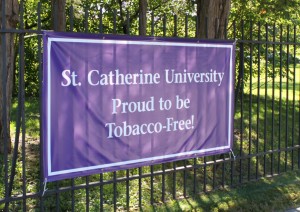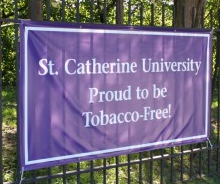St. Catherine University officially went tobacco-free this school year, becoming the second MIAC school to do so, after Bethel University.
St. Kate’s Minneapolis campus has been tobacco-free since August 2008, and the St. Paul campus went tobacco-free Sept. 1. Seventy percent of the St. Kate’s community supported the decision to go completely tobacco-free, according to the St. Kate’s website.

The effort began in 2007 with the establishment of the Tobacco-Free Committee. The leading force behind the effort was Amy Kelly, St. Kate’s health and wellness center director.
“Overall the response has been very positive,” Kelly said. “So far I think things have gone quite well.”
Even though the new policy was enacted Sept. 1, the tobacco-free effort is far from over, Kelly said.
“We will continue to monitor the process and how the policy is working, [and] if there are aspects that would need to be changed or approaches that might be better,” Kelly said. “I think going tobacco free is truly a ‘process’ and we will continue to participate in the process for the next several years.”
Tobacco-free at St. Thomas?
Two hundred and fifty-four colleges and universities nationwide are completely tobacco-free, including 16 in Minnesota. But all MIAC schools beside St. Kate’s and Bethel University allow tobacco use on campus.
All MIAC schools, including St. Thomas, ban smoking in buildings, and most, if not all (pending Macalester’s new smoking policy), do not allow smoking within a given distance of building entrances.
St. Thomas’ official smoking policy states that all university residences are non-smoking, and smoking is prohibited within 30 feet of building entrances.
This policy does not do enough, said Madonna McDermott, student health services and wellness center director.
“I believe our current policy falls short of ensuring the healthy environment for our entire community and in promoting the healthiest standard for individual and community behavior,” McDermott said.
According to a St. Thomas 2007 core survey, 67 percent of St. Thomas students would support a smoke-free campus, and 17.7 percent of the student body smokes.
But St. Thomas is not currently working to become tobacco free.
“Most of us have heard complaints from students, faculty and staff about being exposed to secondhand smoke while sitting in our residence hall, working in our offices or walking across campus,” McDermott said.
McDermott said a driving force is needed in order to push a policy like this, and that force currently does not exist. Students have not been overly emphatic about this issue, McDermott said.
“I have worked with various students in the past who have been interested in moving the tobacco-free campus agenda forward, but it has never gained much momentum,” McDermott said.
The tobacco-free policy has not been discussed because no one has made it a hot topic, she said.
“It will take a community effort to create a change in policy in regards to a tobacco-free campus and I do hope that St. Thomas will become one of the rapidly growing number of campuses across the nation to become tobacco-free,” McDermott said. “If students desire a tobacco-free campus, I believe it will happen.”
There was a draft tobacco policy proposed in 2005 by St. Thomas’ Alcohol, Tobacco and Drug Advisory Council. The proposal called for the creation of a single, university-wide tobacco policy that encompassed all campus grounds, vehicles and university-owned buildings and prohibited the use of tobacco on all St.Thomas property. The proposal did not pass.
ADTAC was started in the early 1980s, and membership fluctuated between six and 15 members. It ceased operation a few years ago. The council did not receive university funding, was advisory in nature, and occasionally partnered with the Wellness Center on various initiatives.
“Sadly, very few of the people who were most active on ADTAC are still [at St. Thomas],” said Tom Hodgson, former council member and current adjunct professor and swim coach.
Dan Cook can be reached at cook9156@stthomas.edu.


Banning tobacco would be totally pointless! First of all, it would be a nightmare to enforce and would just result in people disliking public safety even more than they already do. Secondly, people would just cross the street and go smoke (and leave their cigarette butts) in our neighbors yards. If you think people complain about UST students now, wait till they start finding tons of tobacco materials in their yards. Thirdly, I don’t even see a positive effect from banning smoking… as long as people are doing it outside, the only people they are hurting is themselves, I’ve got no problem walking by smokers to get into a building, and anybody who does have a problem has too much time on their hands. Finally, whoever wrote the poll questions on the site is not too bright… the “current rule” about smoking outdoors and 30 feet away from buildings is not a UST “rule,” it’s the Minnesota state LAW! Good luck with changing that.
Go tobacco free. No different than requiring dogs to leave their droppings elsewhere.
I’d be fine with the current rules, except that NO SMOKER on campus — at least not that I have ever seen — actually respect the 30-feet rule. Even friends of mine who generally know better just don’t seem to care, and smoke right in the faces of everyone who walks into OEC or BEC or whatever.
And I’m sick of it. So are my classmates. It’s annoying and gross and smells bad. So ban it. Tobacco-free, UST!
I’m with Mark Furniss on this one, banning tobacco campus-wide is pointless. I totally agree with the indoors and 30 feet + from buildings no smoking rule, and yeah, there are people that violate that rule, but that is a problem with those individual people, not an indication that smoking needs to be banned altogether. Mark, I like the point you make, “as long as people are doing it outside, the only people they are hurting are themselves.” Cigarette smoke disperses very quickly outside, you’re not going to get lung cancer walking across campus and breathing in a miniscule amount of smoke.
I’m very surprised at the timing of this article. This past weekend USG went on it’s annual fall retreat to set goals for the next year. We select three broad initiatives that the entire Council, including the Senate will work to accomplish. One of our three initiatives is to make St. Thomas a Smoke-Free campus. I heartily threw my support behind this effort from the committee level all the way to approval by the USG Council. St. Thomas “not working to become tobacco free” is something that just changed last Saturday. We will of course take time to get things right. I think the committee St. Kate’s set up is a good idea. We will continue to explore many ideas, but I along with most UST students believe it’s time to give ourselves the healthy environment we all deserve.
I too support a ban on tobacco. I just don’t see the benefit and the majority of the campus doesn’t seem to want it. Admittedly the smoking population is inconvenienced, but you can’t please everyone particularly on this subject. The failure to stay 30-feet away probably added to the disdain for on-campus smoking, so smokers should in part blame themselves. I doubt I’ll see a tobacco-free campus, but it would be nice.
Also, the argument of the lesser of two evils is a terrible one. Smokers that throw their butts on our neighbor’s lawn are just disrespectful people and as such I have full confidence they are the same ones throwing cigarette butts on campus. They should just stop doing it and their failure to abide by a simple courtesy should not be an agrument for on-campus smoking.
St. Thomas University has the authority to adopt whatever tobacco use policy they wish just as St. Catherine University has done. Nothing in Minnesota law
requires the school to allow smoking or the use of tobacco products anywhere on campus. Tobacco use is the leading preventable cause of death and illness in the United States. Educators should send a clear message about the harmful effects of using tobacco to students and staff. Public health professionals would argue that the school administration has not only the right but the responsibility to provide a healthy campus for students, staff and visitors. For an institution of higher learning that prides itself on providing the best possible student experience St. Thomas University is behind the curve of this growing national trend.